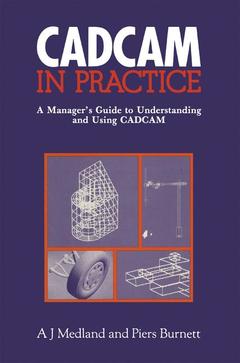CAD/CAM in Practice, Softcover reprint of the original 1st ed. 1986 A Manager's Guide to Understanding and Using CAD/CAM
Langue : Anglais
Coordonnateur : Medland A.J.

Little more than a decade ago computer-aided design and manufacture (CAD/CAM) was a very esoteric field indeed, not one that was of much practical concern to a manager or industrialist unless his business was on the scale of, say, a major automobile manufacturer or in a field of high technology such as aerospace. Like so much else, this situation was revo lutionized by the invention of the silicon chip, the arrival of the micro processor and the dramatic fall in the cost of computer hardware. Today, CAD/CAM has spread down the market, and down the price scale, to the point at which it is both a feasible and an affordable technology for a wide range of small-and medium-sized companies in areas as various as architec ture and general engineering, plastic moulding and consumer electronics. But the explosion - there is no other word for it - in the variety and capabilities of CAD/CAM systems, and their spectacular climb to the top of the hi-tech hit parade, has placed the potential purchaser and user of the new technology in a difficult position. On the one hand he is assured, not least by the manufacturers of CAD/CAM equipment, that a failure to invest in it will leave his company stranded in the industrial Stone Age.
1: CAD — What is it All About?.- Concepts and descriptions.- The design process.- The origins of CAD.- Automated drafting: creating a model.- Representations and simulations.- Analytical programs: simulating performance.- Summary: CAD defined.- 2: CAM — An Introduction.- Design and manufacture: two processes or one?.- Numerical control: the basis of CAM.- Computer-assisted part programming.- Direct numerical control.- Computer numerical control.- The future of numerical control.- Flexible manufacturing systems.- Computer-integrated manufacturing.- Group technology.- Summary: from CAD/CAM to CADAM.- 3: The Elements of a CAD System.- From mainframe to mini.- Enter the micro — distributing ‘intelligence’.- Memory and storage devices.- Machine communicates with man: the graphics display.- Stroke-writing display systems.- Raster display systems.- Man communicates with machine: menus and input arrangements.- Light pen input.- Cursor steering input devices.- Graphics tablet input.- Choosing an input system.- Plotters and other hard copy devices.- 4: Principal Types of CAD System.- Two-dimensional modellers.- Wire-frame modellers.- Surface modellers.- Solid modelling I: boundary representation.- Solid modelling II: constructive solid geometry.- Summary: making a choice of modelling system.- 5: The Software — What CAD Can Do.- Basic drafting.- Macros.- Parametrics.- Graphic conventions.- ‘Drafting’ with primitive solids.- Transformations.- Taking things apart — sectioning.- Putting things together — segmentation and assembly.- Moving things about — simulated operations.- Automatic dimensioning.- Testing things — analytical programs.- 6: A Look Ahead.- Towards standardization?.- Horses for courses: tailor-made CAD.- Extending CAM — computer-aided everything.- Building-in more knowledge — expert systems.- Trends (and limitations) in hardware development.- New roles for CAD.- Near relations: computer graphics and simulators.- 7: Justifying CAD/CAM.- The fallacy of productivity.- Not-so-simple arithmetic.- Saving waste — consistency of information.- Saving time — availability of information.- Saving trouble — analysis of information.- Doing what could not be done before.- 8: Identifying the Needs of a Company.- Who should conduct the feasibility study?.- Geometrical information — the vital commodity.- Where does the information originate?.- How is information stored, communicated and used?.- The place of CAD/CAM in the information structure.- Setting identifiable goals.- 9: Choosing a System and Persuading the Company to Buy It.- ‘Turnkey’ systems.- Assembled systems.- Sources of information.- The politics of CAD.- Making a shortlist.- Benchmarking.- The ‘best’ system?.- Ready, get set....- 10: Buying and Installing a System.- Implementation: the role of the CAD manager.- Planning the installation: physical factors.- Planning the installation: psychological and organizational factors.- Selling CAD to the users.- Training.- The first six months.- Appendix I: Glossary of terms and acronyms used in CAD/CAM.- Appendix II: Checklist for potential purchasers of CAD systems.- Appendix III: Suppliers of turnkey CAD systems in the UK and USA.- Select bibliography.
Date de parution : 03-2012
Ouvrage de 228 p.
15.5x23.5 cm
Disponible chez l'éditeur (délai d'approvisionnement : 15 jours).
Prix indicatif 52,74 €
Ajouter au panier
© 2024 LAVOISIER S.A.S.



